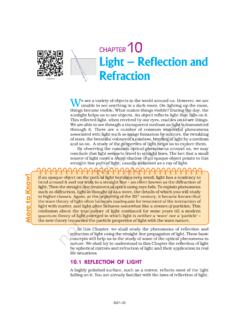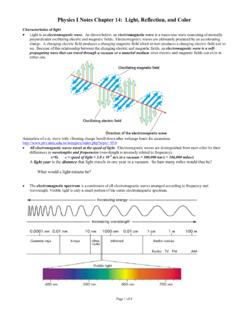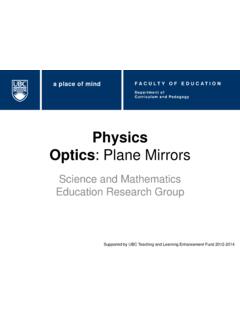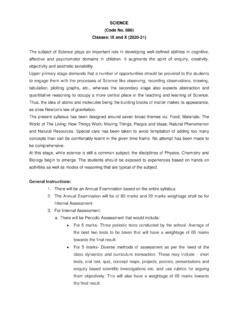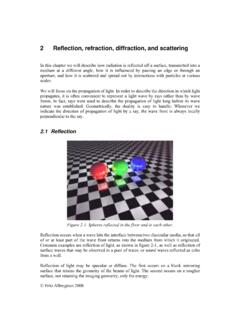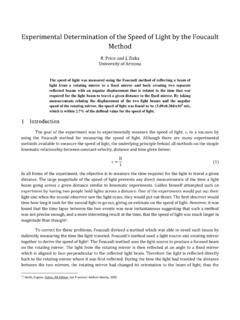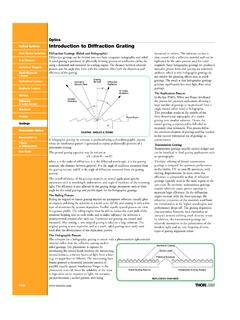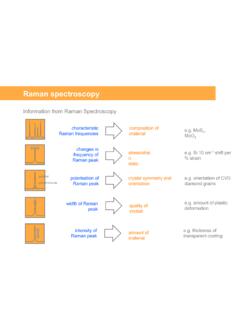Transcription of Introduction to Light and Color - NASA
1 3 Optics: An Educator s Guide With Activities in Science and Mathematics EG-2000-10-64-MSFCI ntroduction to Light and ColorIntroduction to LightLight is a form of radiant energyor energy that travels in waves. SinceGreek times, scientists have debatedthe nature of Light . Physicists nowrecognize that Light sometimesbehaves like waves and, at other times,like particles. When moving from placeto place, Light acts like a system ofwaves. In empty space, Light has afixed speed and the wavelength can bemeasured. In the past 300 years,scientists have improved the way theymeasure the speed of Light , and theyhave determined that it travels atnearly 299,792 kilometers, or 186,281miles, per we talk about Light , we usuallymean any radiation that we can wavelengths range from about16/1,000,000 of an inchto 32/1,000,000 of an inch. There areother kinds of radiation such asultraviolet Light and infrared Light , buttheir wavelengths are shorteror longer than the visible Light hits some form ofmatter, it behaves in different it strikes an opaque object, itmakes a shadow, but Light does bendaround obstacles.
2 The bending of lightaround edges or around small slits iscalled diffraction and makes patternsof bands or Light can be traced to certainenergy sources, like the Sun, anelectric bulb, or a match, but mostof what hits the eye is reflected Light strikes some materials,it is bounced off or reflected. If thematerial is not opaque, the Light goesthrough it at a slower speed, and itis bent or refracted. Some Light isabsorbed into the material andchanged into other forms of energy,usually heat energy. The Light wavesmake the electrons in the materialsvibrate and this kinetic energy ormovement energy makes heat. Frictionof the moving electrons makes , Color , and Their Uses4 Light , Color , and Their UsesOptics: An Educator s Guide With Activities in Science and Mathematics EG-2000-10-64-MSFCI ntroduction to ColorColor is a part of the electro-magnetic spectrum and has alwaysexisted, but the first explanation ofcolor was provided by Sir IsaacNewton in passed a narrow beam ofsunlight through a prism located ina dark room.
3 Of course all the visiblespectrum (red, orange, yellow, green,blue, indigo, and violet) was displayedon the white screen. People alreadyknew that Light passed through aprism would show a rainbow or visiblespectrum, but Newton s experimentsshowed that different colors are bentthrough different angles. Newton alsothought all colors can be found inwhite Light , so he passed the lightthrough a second prism. All the visiblecolors changed back to white is the only source of Color of an object is seen becausethe object merely reflects, absorbs, andtransmits one or more colors thatmake up Light . The endless variety ofcolor is caused by the interrelationshipof three elements: Light , the source ofcolor; the material and its response tocolor; and the eye, the perceiver of made by combining blue,yellow, and red Light are calledadditive; and they are formed byadding varying degrees of intensityand amounts of these three primary colors of Light arecalled cyan (blue-green), yellow, andmagenta (blue-red).
4 Pigment Color found in paint, dyes,or ink is formed by pigment moleculespresent in flowers, trees, and Color is made by absorbing, orsubtracting, certain parts of thespectrum and reflecting or transmittingthe parts that remain. Each pigmentmolecule seems to have its owndistinct characteristic way of reflecting,absorbing, or transmitting certainwavelengths. Natural and manmadecolors all follow the same natural : An Educator s Guide With Activities in Science and Mathematics EG-2000-10-64-MSFCI ntroduction to MirrorsAs we look around the room, wesee most objects by the Light that isdiffusely reflected from reflection of Light takesplace when the surface of the objectis not smooth. The reflected rays froma diffusely reflecting surface leave thesurface in many different to mirrors and LensesWhen the surface is smooth, suchas the surface of glass or a mirror,then it can be easily demonstratedhow reflected rays always obey thelaw of reflection as illustrated , Color , and Their Uses6 Light , Color , and Their UsesOptics: An Educator s Guide With Activities in Science and Mathematics EG-2000-10-64-MSFCM irrorImage of Object(Virtual Image)ObjectLaw of ReflectionThe angle of incidence is equal tothe angle of Image Formed byReflection in a Flat MirrorEvery object we see has many raysof Light coming from it either byreflection or because it is a lightsource such as a Light bulb, the Sun,a star, etc.
5 Each point on that objectis a source of Light rays. In theillustration below, the tip of the arrowis used as an example of a point on theobject from which rays of Light wouldbe coming. As the rays from the objectSmoothReflectingSurfacei = Angle of Incidencer = Angle of Reflectionr = iir(See Glossary,page 63.)are reflected by the mirror, thereflected rays appear to come from theimage located behind the mirror at adistance equal to the object's distancefrom the mirror. The image is called avirtual image since the rays do notactually pass through or come fromthe image; they just appear to comefrom the image as illustrated : An Educator s Guide With Activities in Science and Mathematics EG-2000-10-64-MSFCThe Image Formed by aConcave MirrorA concave mirror that is part of aball or hollow sphere (that is, it hasa circular cross section) is a sphericalmirror. The focal length is approximatelyone-half the radius of curvature. A raythat is both parallel and very close tothe optical axis will be reflected by themirror so that it will cross the opticalaxis at the paraxial focal point.
6 Theparaxial focal point is located adistance of one-half the radius ofcurvature from the point on the mirrorwhere the optical axis intersects themirror. The word paraxial comes fromthe Greek para or par meaning atthe side of, or beside, and axial. Thusparaxial means beside the ray that is parallel to theoptical axis, but not close to the axis,will be reflected by the mirror so thatit crosses the optical axis, not at theparaxial focus, but a small distanceConcaveMirrorRealImageObject(2)( 1)cRadius ofCircle(3)fOpticalAxiscloser to the mirror. This difference inthe axis cross-over points is calledspherical the mirror has a cross sectionthat is a parabola instead of a circle,all of the rays that are parallel to theoptical axis will cross at the samepoint. Thus, a paraboloidal mirror doesnot produce spherical aberration. Thisis why the astronomical telescopeknown as the Newtonian (invented byIsaac Newton) uses a paraboloidalprimary demonstration purposes inthe classroom, it works out that we canmake the approximation that sphericalmirrors behave almost like paraboloidalmirrors and determine that the focallength of a spherical mirror is aboutone-half the radius of curvature ofthe , Color , and Their Uses8 Light , Color , and Their UsesOptics: An Educator s Guide With Activities in Science and Mathematics EG-2000-10-64-MSFCIn the case where the object islocated between the focal point andthe mirror, such that the objectdistance is less than the focal lengthof the mirror, a virtual, upright, andenlarged image is obtained.
7 This isthe case when looking at yourself ina concave make-up mirror, which isdescribed ray (1) appearing to come fromthe focal point strikes the mirror andis reflected parallel to the optical ray (2) parallel to the optical axis isreflected by the mirror so that it goesthrough the focal point. A ray (3) strikingthe mirror at the optical axis is reflectedso that the angle of reflection is equalto the angle of ray diagram below uses threereflected rays to illustrate how theimage can appear to be enlarged andupright. The image formed is a Image Formed by aConvex MirrorThe image formed by a convexmirror is virtual, upright, and smallerthan the object. This is illustrated bythe ray diagram on the following diagram depicts the three raysthat are discussed in the ray (1) parallel to the optical axisis reflected as if it came from the focalpoint (f). A ray (2) directed toward thefocal point is reflected parallel to theoptical axis.
8 A ray (3) striking themirror at the optical axis is reflectedat an angle equal to the angle (1)(3)(2)ObjectImageOpticalAxisConcave Mirror9 Optics: An Educator s Guide With Activities in Science and Mathematics EG-2000-10-64-MSFCC onvex MirrorObject(3)(1)c(2)fImageirOpticalAxi sIntroduction to LensesA simple lens is a piece of glass orplastic having two polished surfacesthat each form part of a sphere or of the surfaces must be curved;the other surface may be curved orflat. An example of a simple lens wouldbe obtained if a piece of a glass ballwere sliced off as shown in thefollowing piece of the ball sliced offwould be a lens with a spherical sideand a flat side. Lenses can be madein a variety of shapes for variousapplications. Some examples of lensshapes are illustrated BallLens(1)(2)(3)(4)(5)A lens thicker in the center thanat the edge is called a converging orpositive lens. A lens thinner at thecenter than at the edge is calleda diverging or negative lens.
9 In theillustration shown, lenses 1, 2, and 3are converging or positive 4 and 5 are diverging ornegative , Color , and Their Uses10 Light , Color , and Their UsesOptics: An Educator s Guide With Activities in Science and Mathematics EG-2000-10-64-MSFCThe Image Formed by aConverging LensWhen using a thin lens, that is, thethickness at the center of the lens isnot too great, a thin lens mathematicalapproximation can be used. Thisapproximation assumes the bending oflight occurs in one plane inside ray of Light coming from a verydistant object, such that the ray isparallel to the optical axis, will be bentby refraction at the two surfaces of thelens and will cross the optical axis atthe focal point (f) of the lens, as seenin the illustration below. A ray passingthrough the center of the lens willpass through the lens (1)(2)The size and location of an imageformed by a lens can be found by usingthe information from these two rayswhich is shown in the illustration following illustration depictstwo rays, which are defined in thefollowing text.
10 A ray (1) parallel tothe optical axis passes through thefocal point (f). A ray (2) passingthrough the center of the lens image is real, smaller than theobject, and upside down. If a piece ofpaper is placed at the image location,a real image can be seen on the example of this is taking a picturewith a camera, where the photographicfilm is located at the image #1 Ray #211 Optics: An Educator s Guide With Activities in Science and Mathematics EG-2000-10-64-MSFCA Simple MagnifierWhen the object lies between thelens and the focal point, a virtual,upright, and enlarged image is obtained,as seen in the illustration rays are included in theillustration. Following are descriptionsof these rays. A ray (1) leaving theobject parallel to the optical axis willbend at the lens and go through thefocal point (f). A ray (2) leaving theobject going through the center ofthe lens will be undeviated. A ray(3) leaving the object as if it camefrom the front focal point of the lenswill bend at the lens and travel in aline parallel to the optical Axisf(3)(1)(2)fAfter passing through the lens, thethree rays described above will appearto come from an enlarged and uprightimage.










